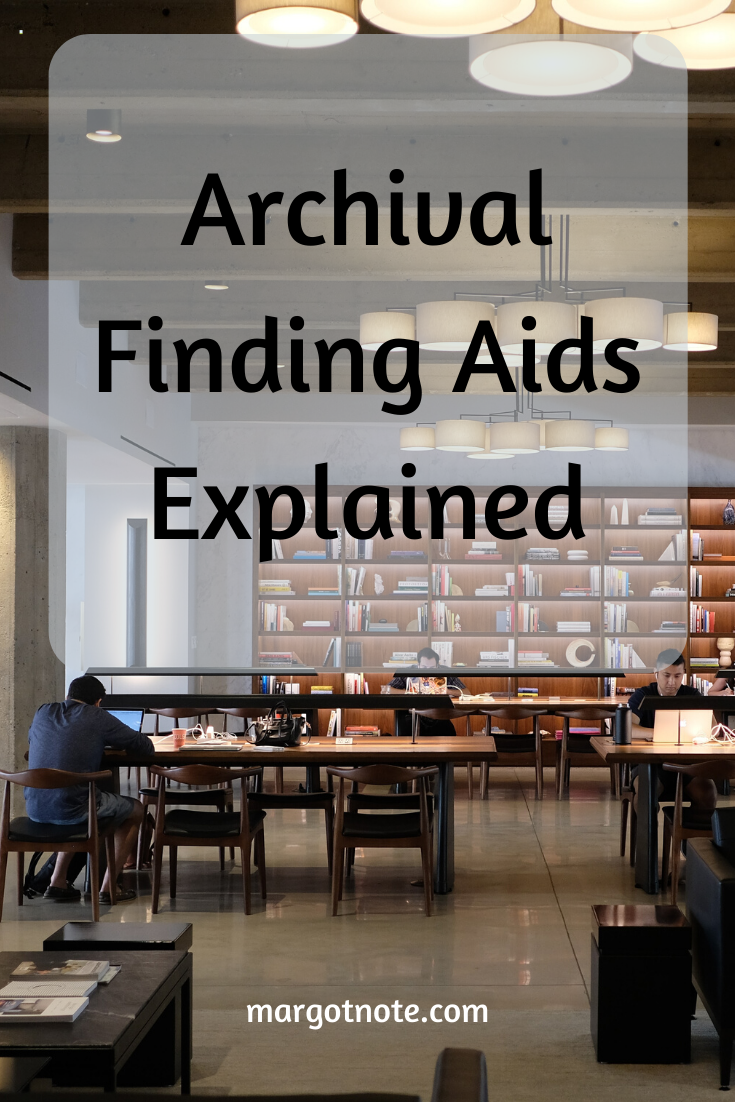A finding aid is a term used by archivists to describe the various kinds of written descriptions they produce about collections. An aid can be any descriptive tool: published or unpublished, manual or electronic, produced by the creator, the records management program, or the archival repository.
These guides were captured on paper for years, then were created in Word and Excel documents. Now, they’re frequently encoded using Encoded Archival Description (EAD), a standardized system that allows users to find primary sources more easily.
Finding Aid Elements
Finding aids begin with a title page, which includes the title, dates, repository name, the name of the person who created finding aid, and the date the finding aid was created. If there’s no title page, the beginning of the document contains this information.
The administrative and biographical history provides contextual information in terms of the biography of the person or the history of the organization. It gives an overview, not the complete story, with a focus on the period that the records derived from. The section summarizes the functions, activities, events, and changes that are necessary to understand the materials; this information relates to provenance.
The description section is the explanation of the materials in terms of their contents, arrangement, and physical characteristics. It includes the strengths and weaknesses of the collection and identifies depth and gaps. It can include information on the ways that records were generated and maintained, which is distinct from the administrative and biographical history section. The overall description of the collection is traditionally called the scope and content note. If the collection is extensive, with defined series, an additional narrative describes each series and how those series are arranged.
In the administrative information section, the archivist provides whatever information is necessary to use the collection, such as restrictions or copyright information.
Container and folder lists include the box- and folder-level descriptions of how the files are stored so users can identify what they want to see and gauge the quantities of the materials.
Additional information can include any collateral data that would be useful to researchers, such as a glossary of terms, a bibliography, organizational chart, family tree, or other items.
In some cases, there is further guidance to the collection in the form of an index, such as a list of significant correspondents.
Internal and External Guides
Finding aids fall into two categories: internal and external.
Internal finding aids are usually a combination of catalogs, inventories, lists, and databases produced by or supported by the repository and used inside the repository or on the repository’s intranet. It’s impossible to remember all aspects of a collection, although there will inevitably be information that isn’t written down. Internal finding aids are often distinctive and unique to each repository. For example, in a position I held for an institutional archives, I had created EADs and Word-based finding aids for some collections. I also maintained other collections through an Access database. Someone new to the archives would have difficulty locating materials with this system, but I became a superuser through my frequency of usage and my knowledge of the collections that developed over the years.
The repository or outside parties can issue external finding aids. The purpose of the external guides is to attract researchers. Examples are journal notices, exhibits, online or book guides, or national guides like the National Union Catalog of Manuscript Collections (NUCMC). Finding aids can also be published on websites or shared via the ArchiveGrid interface. These guides usually provide an overview of the collection for an audience new to the materials well as box- or folder-level inventories of the primary sources they describe.
Surrogate to the Collection
So, what are finding aids? A finding aid acts as a surrogate to the collection. It describes the collection as a whole and provides information on the people and activities that created the collection. It informs researchers about the organization of the collections and points researchers to where they might find material of interest. A finding aid, whatever the format it embodies, provides a valuable key to accessing collections of primary sources.
The blog was originally published on Lucidea's blog.































